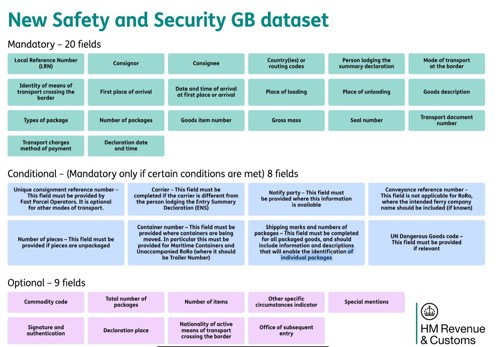Businesses importing goods from the EU to the UK will need to complete safety and security (S&S) declarations from the 31st of January 2025. UK customs will gain extra information about their shipments as a result of this. This change is the last step in implementing the Border Target Operating Model (BTOM).
What is GB S&S?
S&S GB refers to the Entry Summary Declaration (ENS) system required for goods arriving in Great Britain from both the EU and other global locations. This allows HMRC and border authorities to assess potential risks associated with goods before they enter the UK, and it applies across all transportation methods. Unlike import customs declarations, the ENS is a separate need and does not include any duties or taxes.
When does it come into effect?
Safety and Security (S&S) declarations for EU imports to the UK will come into effect on 31 January 2025.
Why is the S&S change required?
The need for Safety and Security (S&S) declarations is driven by the shift to modern digital border management systems. These enable UK authorities to assess and manage risks on imports, helping protect national security. These requirements are not new globally, the UK has required S&S declarations for imports from outside the EU for some time.
With Brexit, the UK now falls outside the EU's shared safety and security area, meaning S&S declarations are needed for goods arriving from the EU as well. Starting on 31 January 2025, most commercially transported goods will require an Entry Summary Declaration (ENS), ensuring all imports are screened effectively.
There are a few exceptions to this rule. Personal goods brought into the UK by individuals without any contractual shipping arrangement, such as those carried by a private individual in their car, do not need an ENS declaration.
Who will be affected?
All individuals and businesses importing goods from the EU using a commercial carrier will be required to submit an Entry Summary Declaration (ENS).
This declaration must be made at least 2 hours before the goods arrive at an EU ferry port, or 1 hour before arrival if using Eurotunnel. Compliance is essential for all parties involved in the import process, ensuring goods are screened effectively before entering the UK.
Who is responsible for the declaration?
The legal obligation to submit the Entry Summary Declaration (ENS) lies with the haulier for goods transported via accompanied road freight, meaning by truck.
While hauliers may choose to engage a customs intermediary to handle this declaration on their behalf, the ultimate legal responsibility still resides with the haulier. Hauliers need to understand that any arrangement with an intermediary does not absolve them of their obligation to ensure the ENS is submitted accurately and within the required timeframes.
What information is contained in the ENS?
20 mandatory fields need to be completed, along with 8 conditional fields, and 9 optional fields. Here’s a guide to what those fields are:
Mandatory fields
- Local reference Number (LRN)
- Consignor
- Consignee
- Country(ies) or routing codes
- Person lodging the summary declaration
- Mode of transport at the border
- Identity of means of transport crossing the border
- First place of arrival
- Date and time of arrival at first place or arrival
- Place of loading
- Place of unloading
- Goods description
- Types of package
- Number of packages
- Goods item number
- Gross mass
- Seal number
- Transport document number
- Transport charges method of payment
- Declaration date and time
Conditional fields
- Unique consignment reference number - This field must be provided by Fast Parcel Operators. It is optional for other modes of transport
- Carrier - This field must be completed if the carrier is different from the person lodging the Entry Summary Declaration (ENS)
- Notify party - This field myst be provided where this information is available
- Conveyance reference number - This field is not applicable for RoRo where the intended ferry company name should be included (if known)
- Number of pieces - This field must be provided if pieces are unpackaged
- Container number - This field must be provided where containers are being moved. In particular this must be provided for Maritime Containers and Unaccompanied RoRo (where it should be Trailer Number)
- Shipping marks and numbers of packages - This field must be completed for all packaged goods, and should include information and descriptions that will enable the identification of individual packages
- UN Dangerous Goods code - This field must be provided if relevant.
Optional fields
- Commodity code
- Total number of packages
- Number of items
- Other specific circumstances indicator
- Special mentions
- Signature and authentication
- Declaration place
- Nationality of active means of transport crossing the border
- Office of subsequent entry

Image Credit: HMRC
Ensuring compliance with Safety and Security declarations
A significant portion of the information necessary for the Entry Summary Declaration (ENS) is likely already present within the supply chain. The key will be to enhance communication with carriers, many of whom may be non-UK entities, which could require additional effort.
Some carriers might lack access to the systems needed to manage the ENS declaration effectively. This is where customs intermediaries can provide valuable support. Fortunately, many customs intermediaries in the UK already have systems in place to facilitate ENS submissions. It's advisable to reach out to your chosen intermediary before the deadline of January 31, 2025, to initiate discussions and ensure a smooth compliance process.
If you have questions or need help with Safety and Security Declarations, feel free to reach out to our team at SEKO Logistics. We're here to assist you and provide the support you require.
FAQs About S&S Declarations in the UK
What is the BTOM and how does it relate to Safety and Security Declarations?
The Border Target Operating Model (BTOM) is a framework implemented by the UK government to enhance border management and security following Brexit.
It aims to create a streamlined and efficient customs process for goods entering and leaving the UK. The introduction of Safety and Security Declarations (S&S) is a crucial aspect of BTOM, allowing UK authorities to assess and manage risks associated with imports. By implementing these declarations, the UK aligns with international standards for border security, ensuring that all goods are screened for safety before entering the country.
What are the key dates and timelines related to S&S declarations?
- January 31, 2025: Implementation date for Safety and Security Declarations for EU imports.
- Before January 31, 2025: Businesses are encouraged to register with customs intermediaries and start discussions to prepare for compliance.
What are the consequences of non-compliance with S&S declarations?
Failing to submit the Entry Summary Declaration (ENS) on time can result in significant penalties, including fines and delays in goods being allowed to enter the UK.
Non-compliance may also lead to increased scrutiny of future shipments, affecting a business's ability to operate efficiently across borders. Businesses must prioritise compliance to avoid these risks.
What helpful resources and tools are available for completing ENS declarations?
Businesses can access various resources to assist with ENS declarations:
- HMRC’s official website: Provides guidance and resources on compliance and submission procedures.
- Customs intermediary services: Many UK customs intermediaries offer software solutions that streamline the ENS submission process.
- Industry associations: Organisations like the British International Freight Association (BIFA) offer resources and training on customs compliance.
What are the best practices for ensuring compliance with the new regulations?
To ensure compliance with Safety and Security Declarations, businesses should consider the following best practices:
Enhance communication with carriers
Establish clear lines of communication with all carriers involved in the import process to ensure they are aware of the S&S requirements.
Update information systems
Ensure that your logistics and customs management systems are equipped to handle the mandatory fields for the ENS.
Engage customs intermediaries early
Reach out to your chosen customs intermediary well before the deadline to discuss processes, tools, and any required information for compliance.
Conduct training
Provide training for your staff on the new requirements and processes associated with S&S declarations to ensure everyone is well-informed.



